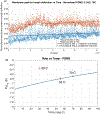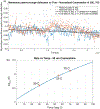Creep deformation in elastomeric membranes of liquid-filled tunable-focus lenses
- PMID: 31503794
- PMCID: PMC7409532
- DOI: 10.1364/AO.58.006446
Creep deformation in elastomeric membranes of liquid-filled tunable-focus lenses
Abstract
Liquid-filled tunable-focus lenses have been demonstrated to be suitable for autofocus eyewear applications. Traditionally, these lenses are constructed using an elastomeric polymer chamber filled with a high-index liquid. In this work, we investigate the effect of elastomeric creep on the deformation and eventual degradation of these tunable lenses. We use numerical analysis of a deformable circular disk representative of the lens and provide rigorous experimental results testing the creep property of a number of elastomers. Finally, we provide a comparative study of different elastomeric materials and select the best one for this application.
Figures










Similar articles
-
Tunable lenses using transparent dielectric elastomer actuators.Opt Express. 2013 Apr 8;21(7):8669-76. doi: 10.1364/OE.21.008669. Opt Express. 2013. PMID: 23571956
-
Tunable polymer lens.Opt Express. 2008 Aug 4;16(16):11847-57. doi: 10.1364/oe.16.011847. Opt Express. 2008. PMID: 18679457
-
A high numerical aperture, polymer-based, planar microlens array.Opt Express. 2009 Oct 26;17(22):19908-18. doi: 10.1364/OE.17.019908. Opt Express. 2009. PMID: 19997214
-
Recent Developments in Optofluidic Lens Technology.Micromachines (Basel). 2016 Jun 10;7(6):102. doi: 10.3390/mi7060102. Micromachines (Basel). 2016. PMID: 30404276 Free PMC article. Review.
-
Electrically Tunable Lenses: A Review.Front Robot AI. 2021 Jun 9;8:678046. doi: 10.3389/frobt.2021.678046. eCollection 2021. Front Robot AI. 2021. PMID: 34179110 Free PMC article. Review.
References
-
- Tyson RK, Principles of Adaptive Optics (CRC Press, 2011).
-
- Ren H and Wu ST, Introduction to Adaptive Lenses (Wiley, 2012).
-
- Varioptic, http://www.varioptic.com.
-
- Optotune, http://www.optotune.com.
-
- Yu H, Zhou G, Chau FS, and Sinha SK, “Tunable electromagnetically actuated liquid-filled lens,” Sens. Actuators A, Phys 167, 602–607 (2011).
Grants and funding
LinkOut - more resources
Full Text Sources

